Arm Exercises for Weightlifting: Are They Important?
Author:
Reviewed by:
(21 years of Oly Lifting experience)
Unlock your full potential by engaging with our experts and community! Have questions about your fitness journey or looking for expert advice on weightlifting techniques? Don’t hesitate — leave a comment below and Sergii Putsov will provide a personalized answer and insights to help you reach your goals.
Torokhtiy is reader-supported. Some links are affiliate links, and we may earn a commission at no extra cost to you. See our disclosure page for details.
Every lifter is familiar with the idea that a big result in snatch and clean and jerk is only possible if power will be smartly combined with technique, control and mental strength. It means that all philosophy of the training program is about finding balance between mastership & strength. I outline this, because today our topic is arm muscles development.
For Olympic weightlifters, arm training is essential for optimum performance. Strong arms provide stability and control in executing complex lifts, like the snatch and clean & jerk. Moreover, arm exercises for weightlifting mitigate injury risk, improving safety and longevity in this highly demanding sport.
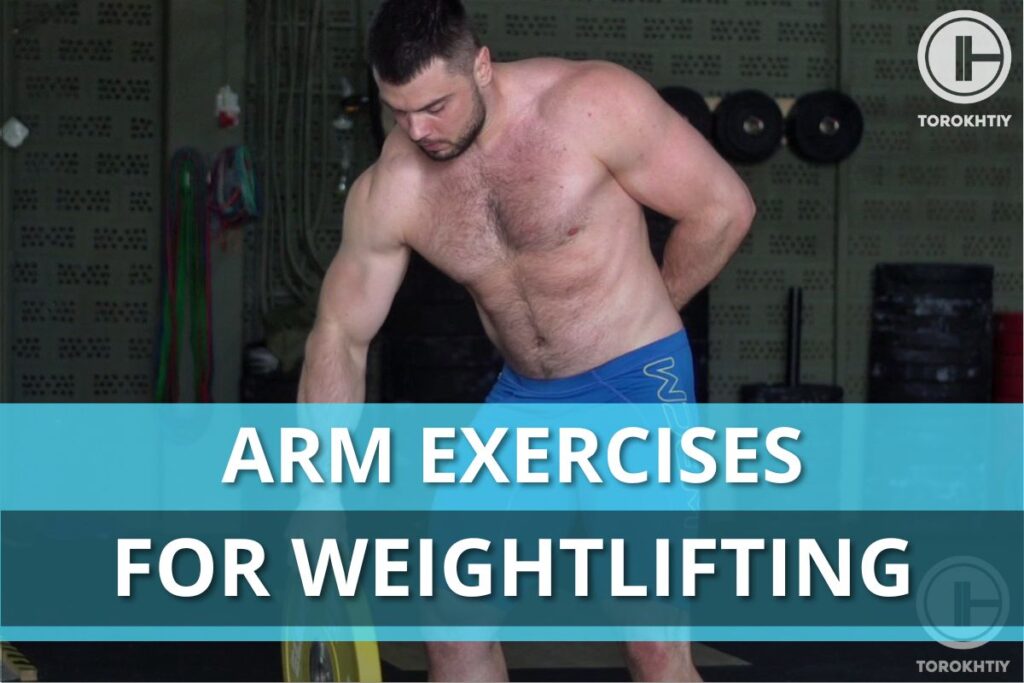
Why It’s Important To Train Arm Muscles For Weightlifters
Arm, as an upper limb, consists of a few complex muscle groups.
Let’s outline main:
- arm muscles (biceps, triceps)
- forearm muscles (responsible for hand and fingers movements)
- wrist and hand muscles (mostly manage specific and precise actions)
From the perspective of biomechanics they provide strength for barbell stabilization in overhead position, also acting as a chain for pulling phases of thу snatch and clean, play essential role in transferring energy from big muscles (legs and back) to the bar.
Smart weight lifting techniques for arms can improve performance and reduce risk of injuries by strengthening these parts of the body.
It is necessary to emphasize that focused impact on building and pumping muscles in the upper limbs can be counter productive for Olympic weightlifting training.
Let’s find out why:
1. Lack Of Mobility And Upper Body Stiffness
Olympic weightlifting consists of technically complex movements that require a significant mobility level. Snatch and C&J demand specific grips and skill to change direction of the movement instantaneously. Bulky muscles in biceps and forearms can definitely restrict ROM to perform well. Large biceps are always an issue for front rack position in C&J. Same like huge forearms can be a limiting flexibility factor for wrists and bring problems in barbell control. That is why a weightlifter arm is not only just a big piece of meat. It is supposed to be mobile, fast and explosive.
2. Loosing of Functional Strength
Olympic weightlifting is a full body sport and it is not about building just huge triceps or biceps. Most power for Olympic lifts comes from big muscle groups, such as core, legs and back. Also it is very important to keep in mind that weightlifting is not just about stupid raw strength, it is about how you can apply it. That is why training focused on building an arm can bring a lot of problems.
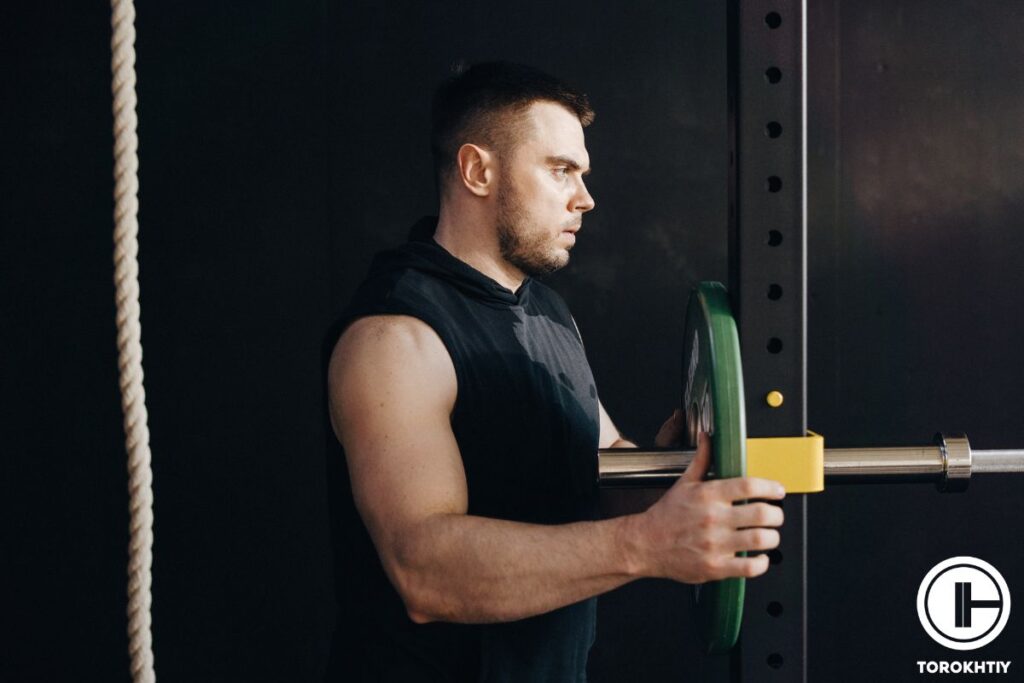
3. Overtraining Risks
The arm muscles are seriously involved in the lifting process in many OLY exercises. That is why adding more load brings risk to overuse biceps and triceps and can cause chronic fatigue and even injuries. It’s essential to recognize that as you incrementally add more load to your lifts, you also exponentially increase the stress placed on these muscles. This additional stress can lead to an overuse syndrome.
Overuse of the biceps and triceps stems from repeatedly exerting these muscles without providing them with enough time to recuperate. The more these muscles are worked without adequate recovery, the more susceptible they become to chronic fatigue. This fatigue is not just physical; it can manifest psychologically as well, leading to decreased motivation, mood changes, and even impaired athletic performance. Moreover, persistent overtraining of the arm muscles can have more serious implications such as injuries.
These could range from mild conditions, like muscle strains, to more severe cases, including tendonitis, bursitis, or even muscle ruptures. Such injuries not only hinder athletic performance but also require substantial recovery time, which could disrupt an athlete’s training routine and competitive schedule. Given these risks, it is vital to approach arm training with a strategic balance.
4. Imbalanced Physique
If you are a weightlifter you probably know that every part of your body has a specific role and must work in harmony to perform snatch and C&J. If you over focus on arm weight workout , you will throw off your lifting mechanics. And this can lead to ineffective performance and increased risk of injury.
5. Less Attention to Technique
Keep in mind weightlifting is much more about movement than is about strength (especially in arm muscles). Too much sets on arm muscle can just seal time from tech training. Mastery of phases like first and second pull, power position, turnover and catch significantly improve your performance.
In the same time smart weight lifting exercises for arms has some benefits for Olympic weightlifting:
6. Better Performance
Strong grip, effective work of elbow and wrist joints, better bar control can lead to efficient lifting and potentially help lift more weight and improve results in snatch and C&J.
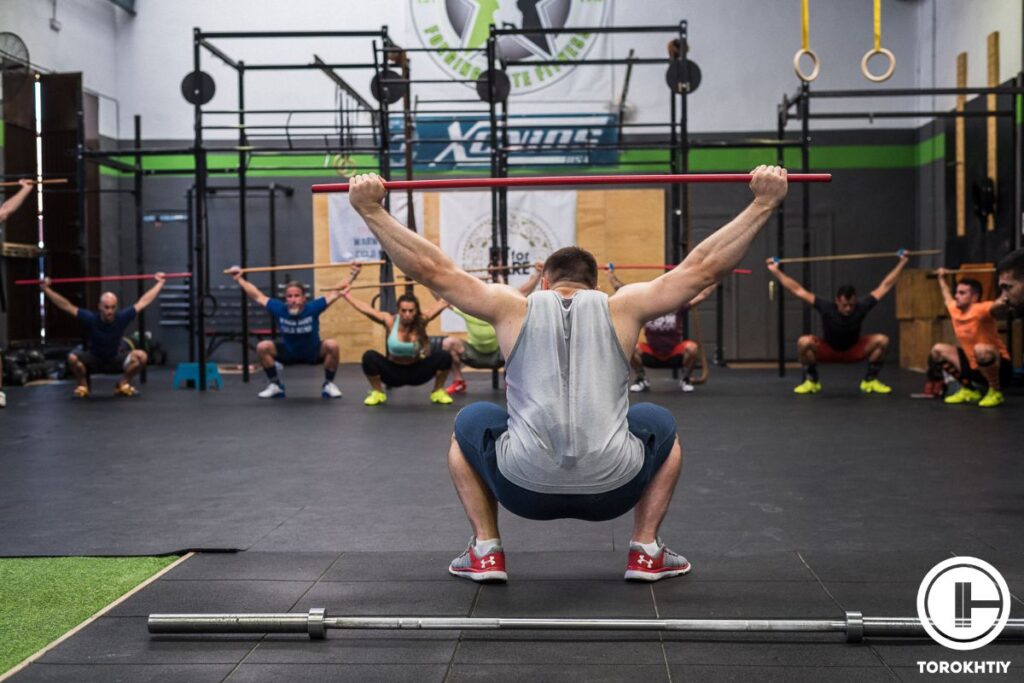
7. Effective Energy Transfer
The main idea of Olympic lifts is a smooth energy transfer from big muscles to the bar. In this chain arms are vital links. And stronger arms can make lifting more efficient.
8. Better Performance
Strong grip, effective work of elbow and wrist joints, better bar control can lead to efficient lifting and potentially help lift more weight and improve results in snatch and C&J.
9. Injury Prevention
Olympic weightlifting is definitely about huge stress on the full body. Strengthening arms muscles can ensure that smaller muscle groups are ready to handle this pressure and will help to avoid tears and strains.
10. Effective Energy Transfer
The main idea of Olympic lifts is a smooth energy transfer from big muscles to the bar. In this chain arms are vital links. And stronger arms can make lifting more efficient.
11. Control and Stability
In the snatch and clean & jerk barbell path and catch point must be controlled with great precision. Strong arms can improve this ability and ensure effective lift.
Yes, arm strength is important in Olympic weightlifting, but at the same time it is very important to maintain a balanced training approach. Arm muscle pumping should not be prior to technique, mobility and overall body balance.
Why Is Strong Grip Important in Deadlift?
Before we will speak about specific arm weight lifting, we need to remember the anatomy and function of these muscles.
1. Biceps Brachii
The biceps location is on the front upper arm and its main function is arm curling in elbow and shoulder joints. A Classic example of biceps exercise is the barbell curls.
2. Triceps Brachii
The tricep location is at the back of the upper arm and its main function is arm extension in elbow and shoulder joints. The narrow grip bench press is a good example for this muscle training.
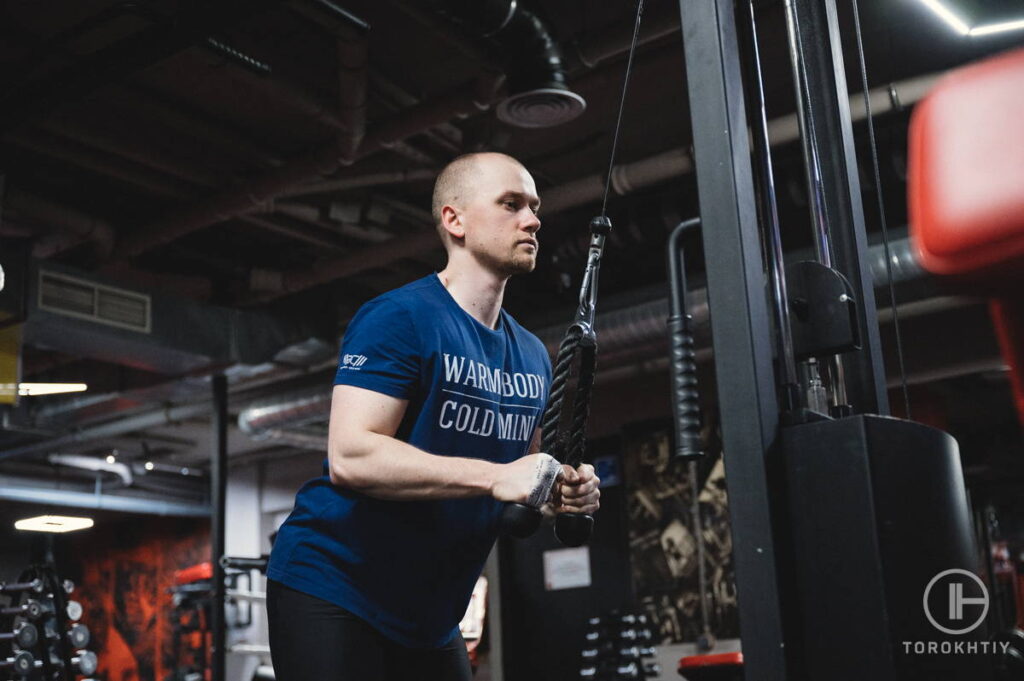
3. Forearm, Hand and Wrists Muscles
It is a big number of small, but long muscles, which are responsible for wrist, fingers and palm movements, they also provide grip strength. The barbell wrist curls exercise is one of the best for forearm muscles development.
Two more important points regarding the topic: “How to get started Building Muscle”
- Honestly, if you are a weightlifter, you should avoid this philosophy. It is way more important to constantly develop the quality of technique and try to build a harmonic and appropriate body for your goals.
- Mosly, smart weightlifters load arms during warmup and activation by using different rubber bands and after the main session with accessory exercises, which we will discuss below.
Now, when we understand these functions we can speak about exercise selection that targets these muscles effectively and will bring the best result for Olympic weightlifting.
Follow us!

Free!
Get a 2-week Weightlifting Program as a bonus for the subscription to kickstart your training plan!

Free!
Biceps Exercises
1. Barbell Curls Reverse Grip
It is probably one useful biceps and brachialis exercise for weightlifters, because if an athlete uses reverse grip, forearm and wrist muscles are working with optimal intensity to provide grip development as well. As an alternative it is fine to use a block machine as well.
Need to take a shoulder-width apart stance, take the bar with overhand grip. It is important to keep elbows close to the torso, maintain straight wrist position and curl the weight. Move the bar up, make 1-2 sec pause and slowly lower down.
2. Dumbbell Hammer Curls
Mostly this exercise is used in the transition period as a part of general physical preparation. It is not recommended to perform it during main preparation, because it can make your arms tight.
This exercise targets both brachialis and biceps. Initial position: shoulder-width apart stance, dumbbells at arm’s length, palms facing torso. Curl the weight and engage biceps. It is possible to curl both arms at the same timу or alternate.
3. Chin-Ups
It is a nice basic and compound exercise for biceps, back, shoulders and forearms. Usually athletes can use it in transitional period or at the beginning of preparation as a part of GPP. It is possible to chin-up with normal and reverse grip as well.
Tricep Exercises
1. Narrow Grip Bench Press
This drill targets shoulders, chest and triceps as well. Initial position: lying on the bench with flat feet on the floor. The close grip stance can vary from shoulder width to fully close. Need to lower the bar slowly to your chest and actively press to the initial position. This exercise is quite useful and popular during all phases of preparation.
2. Dips
Triceps dips target all upper body, effectively shoulders, chest, upper back and forearms. Take the starting position at the dip station, go slowly down and lift your body to full arm straight. This exercise is very functional for OLY lifters, that is why it is common to see it often in different weightlifting programs as a weighted version and just body too.
3. Skull Crushers
Another name of this exercise is Bench French Press. It can be performed with a bar, dumbbells or plate. Very effective for isolated triceps training, elbow extension strength and performance in overhead stability in snatch and jerk.
4. Variations of Overhead Triceps Extensions
Another version of this drill is Standing French Press. It is perfect targeting triceps as well. This movement replicates motion from overhead lifts. This exercise is valuable for developing strength and agility in catch phases in snatch and jerk. As an option, different types of equipment can be used: barbell, block machine, dumbbell, plate.
Forearm Exercises
1. Barbell Wrist Curls (Flexion)
It targets forearm flexors. Need to sit on a bench, put your forearms with a bar on your knees or on a bench with palms up. Let the bar roll down on the end of fingers and the curl fingers and wrists with maximal range of motion. This exercise is one of the most popular among weightlifters of all levels.
2. Reverse Wrist Curls (Extension)
This exercise in opposite impact forearm extensors. The idea of execution is similar to previous, but performed with palms facing down.
3. Farmer’s Walk
Holding weight and walking for distance or for time engages not only grip and forearm muscles, but core as well, improving both grip strength and general strength endurance. This exercise is very beneficial for maintaining control in all phases oа snatch and C&J.
4. Plate Pinches and Juggling
This type of static and dynamic drills develop grip by pinching weight plates between your fingers. Stable and strong grip is essential for solid lifting.
Chest and Triceps Exercises
1. Push-Ups
This is a very useful functional exercise that targets the chest, triceps, shoulders and core. To set the initial position the athlete must get into a hand standing plank position, slowly lower body until chest is a bit from the floor and then push back to the initial position. It is very common in weightlifting to use weighted push-ups with plates on the upper back. This drill is one of the most popular among the weightlifters of all levels.
2. Dumbbell Bench Press
This exercise targets the full upper body with most impact on chest muscles and is not recommended too much for weightlifters. It is fine to do it as a part of the GPP program during the off season and transition period, because a big volume of this exercise can limit shoulder mobility.
3. Incline or Sitting Dumbbell Press
This variation boosts the upper chest, shoulder muscles and triceps as well. There can be few options on how to execute it: both arms at the same time or with alternation. This exercise can enhance the catch phase in snatch and jerk.
Best Wrist and Hand Exercises
Most forearm exercises engage small hand muscles as well. By adding specific options to basic arm exercises it is possiblу to increase lods on wrists and hands. For example you can do push ups standing on fingers or before any wrist exercise add a dead hang on pullup bar for time and work in superset.
How to Mix Weightlifting and Arm Training
It is very important to find balance between the main weightlifting program and specific arm training. You or your coach can integrate load for arm muscles: it can be a part of your specific warm up, part of the main program oк additional sets at the end of session. Be wise, don’t overload arms – as they work during most weightlifting exercises.
So how to incorporate arm training into the different parts of the session?
1. Warm-Up
Usually athletes during specific warmups can execute a decent number of drills to prepare the whole body for intensive lifting. Exercise such as lightweight or rubber band triceps extensions increase mobility and blood flow and prepare them for heavy movements, like snatch, clean etc. This type of arm training not only primes muscles, but also helps to focus on coordination and details.
2. Main Part
Incorporating specific arm exercises into the main part of the session also can be beneficial, especially if it is upper body movement day. All variation of muscle snatches and muscles cleans from different positions target arms muscles, as well as snatch and jerk push presses. Also, during preparation period, it is possible to plan specific strength complexes for arms development, for example;
Hip Muscle Snatch + Snatch Press.
Drills like Barbell Curls Reverse Grip or Incline Close Grip Bench Press can be used as an accessory, as they develop and strengthen these arm muscles for enhancing weightlifting performance.
3. Accessory Training
Using arm drills at the end of the session is also a nice idea. After completing the main load it is fine to add 2-3 sets or even supersets of high rep (12-15 reps) wrists curls of pushups. This can help with small muscle conditioning and will improve muscle control and stability of main lifts.
Keep in mind, arms muscles are 100% involved in Oly lifts, so they are not lazy and not losing strength. It is important for athletes of all levels to listen to the body and pay attention to recovery.
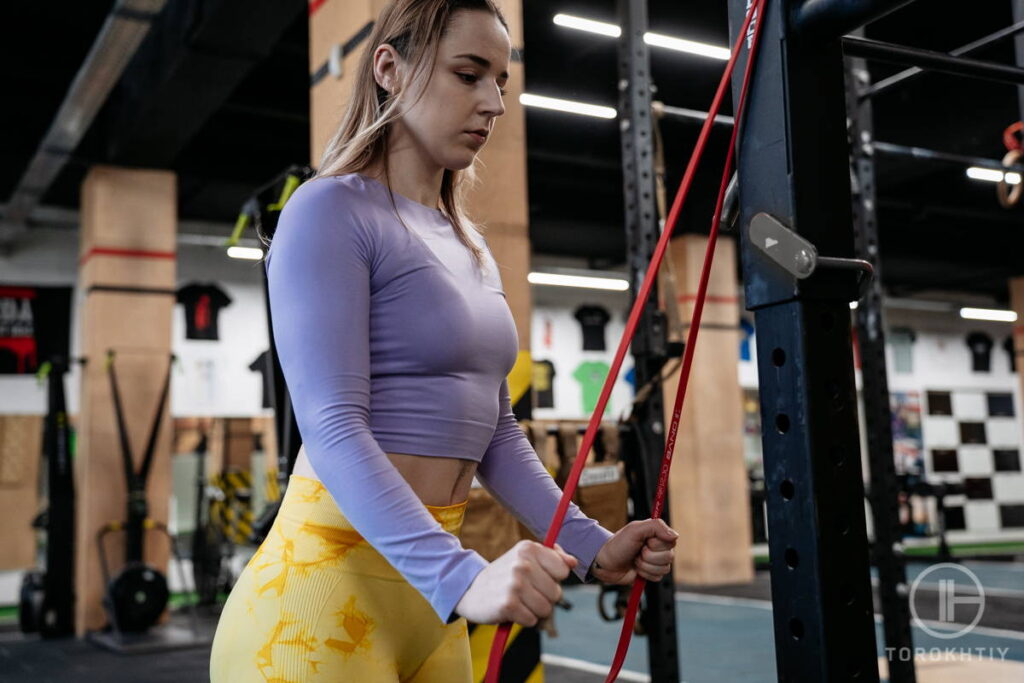
Best Arm Exercises for Weightlifters
1. Muscle Snatch
This movement focuses on the phase of the snatch called turnover, but as a separate drill it targets shoulders, triceps, forearms and can be executed from hip position, above and below knee, starting position. Also there is an option to perform it with snatch, middle and narrow grip.
2. Olympic Weightlifting Presses Variations
All overhead presses definitely target shoulders and triceps as the main muscles, but also a lot of small muscles responsible for stabilization. That is why it is also a good option for arms training. Snatch, Middle and Jerk grip (from shoulders and behind the neck) with full or half amplitude of movement.
3. Rubber band Exercises
Adding a smart and optimal volume of triceps, forearm, biceps in your routine will definitely bring functional and balanced arm strength for better performance in snatch and C&J.
FAQ
What Is A Good Arm Workout With Weights?
There are a lot of types of arm workouts. Let’s give an example of a good basic arm workout. It can be like that:
Warm-up
Biceps Barbell Curls: 3 sets / 10-12 reps
Dumbbell Biceps Curls: 3 sets / 12-15 reps
Narrow Grip Bench Press: 3 sets / 8-10 reps
Dips: 3 sets for max
Wrist Flexion: 2-3 sets / 15-20 reps
Wrist Extension: 2-3 sets / 15-20 reps
Cool Down + Stretching
Pick the appropriate weight to complete all reps.
Technique is always a priority.
How Do You Strengthen Your Arms For Lifting?
If your main goal is strength, focus on compound movements for your lifting arm: bench press, deadlift, rows variations. It will work your arm as well as other muscle groups. Include isolation exercises: Biceps Barbell Curls, Dips, Wrist Flexion / Extension. Mix low rep / heavy weight approach to build brute strength with high rep / medium weight for muscle building. Always prioritize from to get best results and prevent risk of injuries. Remember about balanced diet, recovery and systematic training.
Is Weight Lifting Good For Arms?
Of course, weight lifting is beneficial for strengthening and developing your arms. Smart arm training program targets all arm`s musclу groups, including triceps, biceps, forearms. Also weightlifting can build muscle mass and general fitness. Weight lifting involves compound movements, that is why improve general coordination, agility, stability and functional strength.
Conclusion
In conclusion, arms training in Olympic weightlifting is a specific question and you should be careful in adding load to these muscles. I hope, in this article, we gave you some good tips on how to make it beneficial for your weightlifting journey. Now your turn!
Don’t hesitate to share your thoughts, what are your favorite arm drills?
Also read:
- Weight Bench Guide
- 4 Benefits Of Weightlifting For Seniors + 8 Simple Exercises
- How To Balance Running And Weightlifting?
- Ideal Squat Bar Path Explained By Lifting Coach
- Running Before Or After Lifting: Which Is Best?
- Prilepin’s Chart Guide: Optimize Your Lifts
- Strong Arms, No Pain: Tackling Elbow Discomfort from Weightlifting
- How To Warm Up Before Lifting: Elevate Your Lifts
- 8 Shoulder Warm-up Exercises and Their Benefits
References:
- National Strength and Conditioning Association Position Statement on Weightlifting for Sports Performance // NCBI: https://pubmed.ncbi.nlm.nih.gov/36952649/
- Stress reactions and fractures around the elbow in athletes // JSAMS: https://www.jsams.org/article/S1440-2440(20)30789-1/fulltext
- Upper extremity injuries associated with strength training // NCBI: https://pubmed.ncbi.nlm.nih.gov/11494836/
- Upper Extremity Weight-Training Modifications for the Injured Athlete // Journals: https://journals.sagepub.com/doi/abs/10.1177/03635465980260052301
- Sports-specific injuries // NCBI: https://pubmed.ncbi.nlm.nih.gov/8726314/
Why Trust Us?
With over 20 years in Olympic weightlifting, strength training, nutrition coaching, and general fitness our team does its best to provide the audience with ultimate support and meet the needs and requirements of advanced athletes and professional lifters, as well as people who strive to open new opportunities and develop their physical capabilities with us.
By trusting the recommendations of our certified experts in coaching, nutrition, and sports training programming, as well as scientific consultants, and physiotherapists, we provide you with thorough, well-considered, and scientifically proven content. All the information given in the articles concerning workout programming, separate exercises, and athletic performance, in general, is based on verified data.
The product testing process is described in more detail here.
Author: Sergii Putsov
Head of Sport Science, PhD
Best Results: Snatch – 165 kg,
C&J – 200 kg
Sergii Putsov, Ph.D., is a former professional weightlifter and National team member, achieving multiple medals in the 94 kg weight category at national competitions. With a Master’s degree in “Olympic & Professional Sport Training” and a Sport Science Ph.D. from the International Olympic Academy, Greece, Sergii now leads as the Head of Sport Science. He specializes in designing training programs, writing insightful blog articles, providing live commentary at international weightlifting events, and conducting educational seminars worldwide alongside Olympic weightlifting expert Oleksiy Torokhtiy.
Reviewed by: Oleksiy Torokhtiy
Olympic Weightlifting Champion, PhD in Sport Science
Best Results: Snatch – 200 kg,
C&J – 240 kg
Oleksiy Torokhtiy is a professional athlete boasting 20 years of experience in Olympic weightlifting. With multiple European and World titles under his belt, he has showcased his prowess in two Olympic Games (Beijing 2008 and London 2012). Upon concluding his illustrious career, Oleksiy dedicated himself to coaching. By 2022, he had conducted over 200 weightlifting seminars worldwide. He is the visionary behind an international sportswear and accessories brand known for its motto, “Warm Body Cold Mind.” Additionally, he is an esteemed author and the creator of a series of training programs and eBooks.





Still have questions after reading our article? Unlock your full potential by engaging with our experts and community! Don’t hesitate — leave a comment below and Sergii Putsov will provide a personalized answer and insights to help you reach your goals.